Garden steps ideas: 23 ways to level up your plot
Update your backyard with some new garden steps ideas – from contemporary to classic styles, these looks will get you inspired
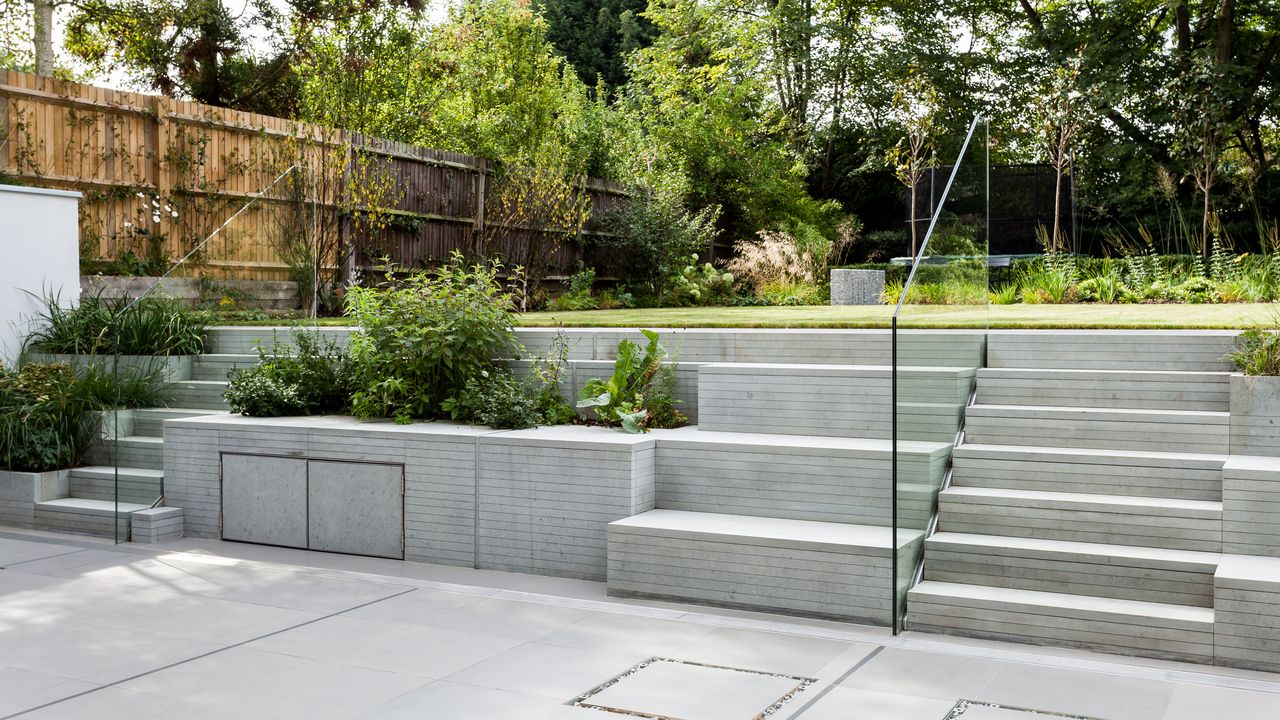

Garden steps can be so much more than just a way to get between different levels. There are all kinds of ideas to try that will make them a stylish feature in their own right.
There are endless options in terms of materials. From industrial Corten steel and smooth limestone paving to patterned tiles and wooden sleepers, they will all add character. Combined with a gorgeous garden path and set alongside plants, furniture, and accessories, they can help create the beautiful look you're after for your backyard.
Of course, safety is important as well as the practicalities and aesthetics. Stairs need to be comfortable and secure to use. And in some instances, they need to comply with building regulations. Always seek professional input for complex projects, as the design specifications will need to be carefully calculated. Don't worry about having to tone down your ideas to meet these stipulations, though, as handrails, balustrades, and glass panels can all add a chic note to the final look.
23 gorgeous garden steps ideas to connect the levels in your plot
We've rounded up our favorite garden steps ideas below to get you inspired for your own backyard update.
1. Try streamlined deck steps
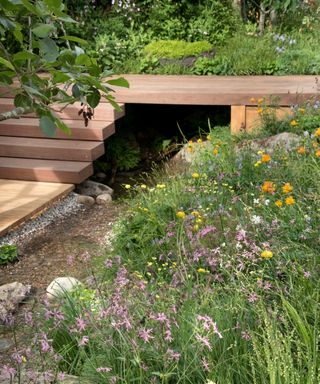
The Chelsea show garden 'The Meta garden; Growing the Future' by Joe Perkins featured decked steps over a tranquil stream
Deck steps make an attractive alternative to paved ones. You could use them to link two outdoor living zones in a tiered plot or a stretch of decking to a lawn, or, as seen here, to connect a raised walkway to a lower level.
Whether using timber or wood-effect composite, they're a smart and structured landscaping idea that's perfect for modern plots. In this garden, they provide a sense of definition against the beautiful, wild planting and trickling stream.
2. Opt for a natural look with rocks and boulders
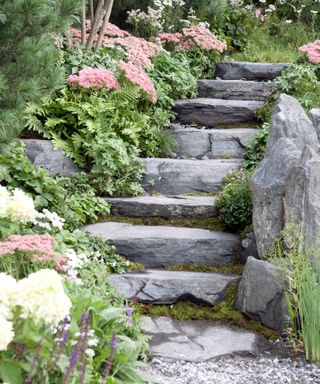
'60° East: A Garden Between Continents', a Chelsea show garden by Ekaterina Zasukhina with Carly Kershaw, featured striking boulders and pretty planting
Take a cue from the great outdoors and try landscaping with boulders in your garden. Sculptural and striking, they almost always look impressive, and look even better when surrounded by plants, such as the ferns and sedum seen here.
Build your steps out of flat-topped rocks to extend the theme. To really create that organic look, avoid using straight lines, and encourage moss to grow in the nooks and crannies between each. It's a lovely solution for steps set away from the main pathways of your garden – perhaps leading to a hidden summer house or hammock.
3. Accent steps with a contrasting material
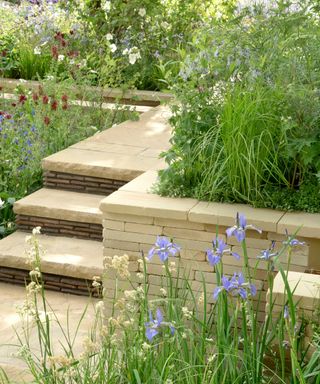
The steps were a stunning feature in Ruth Wilmott's 'Morris & Co' garden at Chelsea Flower Show 2022
The pale stone material of these steps blends beautifully with the raised garden bed and pathway. And the raw natural edge of each slab adds an element of texture and gives the overall look a more natural vibe.
Combined with the surrounding predominant planting palette of soothing blues and greens, it's nothing short of elegant. The use of stacked, red clay tiles on each step's riser adds an element of contrast, making the feature more of a focal point and tying in with the russet-toned blooms behind.
4. Pair pale, paved steps with Corten steel planters
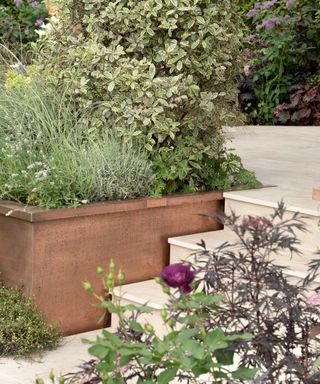
'The SSAFA Garden', designed by Amanda Waring for Chelsea Flower Show 2022, used a lovely mix of materials
The smooth, sleek paving used in this garden is contemporary as well as practical, merging the steps with the levels above and below seamlessly.
If you're going for a similar look, consider using porcelain pavers. As the team at Bradstone says, it's 'a dense and solid material that will maintain its color over time without fading and is resistant to scratches, giving you stunning paving that lasts.’ And nowadays, there are styles available that look just like real stone.
Here, the paved flooring looks wonderful alongside an integrated planter made of Corten steel – an on-trend material that offers durability as well as an industrial-chic aesthetic. The coppery tones contrast attractively against the off-white steps and silvery-green planting, while harmonizing with the deeper, plum-hued foliage also dotted throughout the scheme.
5. Accompany your garden steps with a bright wall and vivid planting
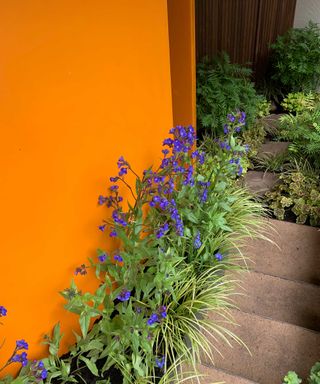
An orange wall made a stunning statement at 'The New Blue Peter Garden – Discover Soil' design, by Juliet Sargeant, for Chelsea Flower Show 2022
Brighten steps set alongside a tall garden wall with a splash of color. This orange hue is full of vibrancy and flair. Terracotta, ochre, azure blue, or perhaps an olive green would make eye-catching alternatives depending on your garden's color scheme.
Soften the two hardscaping features with a row of the best edging plants – the indigo blooms here pop against their backdrop for a modern result.
If you're looking to update your garden steps without having to install new ones, then this is a budget-friendly solution that will make your setup feel refreshed and full of style.
6. Try an interlocking design
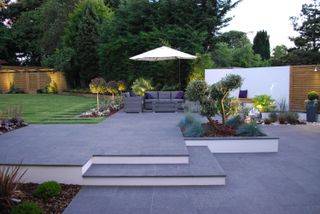
Highlight an interlocking design with smooth paving – such as these black granite step treads from London Stone – and a white render on risers and low retaining walls
A straight flight of steps is not the only option when your garden needs a change in level. Several larger platforms, offset from each other, make a more subtle arrangement that also adds interest and helps widen the overall space too.
This works particularly well with gently sloping gardens so that the riser between each level is minimal and each platform or step is generous. That way, you can use each for displaying a planter or carriage lantern.
7. Go for a coordinated finish
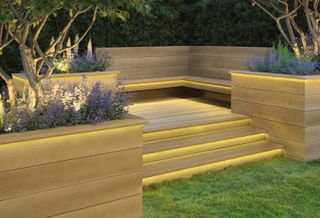
This 'Golden Oak' Enhanced decking from Millboard creates a warm and contemporary feel and looks even more inviting when lit
Opting for the best composite decking is a fantastic choice for a landscaping material as it's so versatile and needs relatively little upkeep. Perfect for constructing steps, seating, retaining beds, and decks, it'll allow you to create a smooth, contemporary outside space where each area flows seamlessly into another.
Excellent installation and attention to detail are key to getting a beautiful result. Choose from flat and molded finishes in a wide selection of shades.
8. Make steps part of the overall design
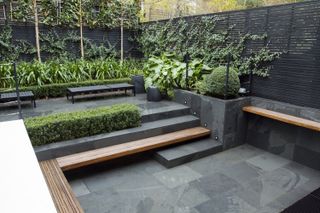
This small garden by The Garden Builders uses stylish landscaping ideas to make the most of the limited space
Steps, outdoor seating, and walls can all work together effortlessly if well planned. Clad them in the same material and paint the surrounding boundaries the same tone to create a look that is super chic and spacious, too.
In this modern courtyard, we love how the wooden bench has been extended to blend into the set of steps. Subtle, recessed spotlights set above each will safely guide the way when night falls.
9. Merge your steps with a rock garden
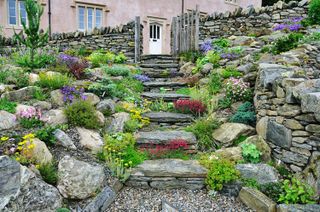
This beautiful rock garden is by Wildroof Landscaping and is packed with year-round color
Steps don't have to be a bold, stand-out feature – they can look just as beautiful integrated as part of the planting.
Rock and woodland gardens are perfect opportunities to casually mix low-growing, creeping plant varieties with informal steps. Choose a natural, slab-shaped material such as timber sleepers or large, split boulders as well-sized treads and encourage a mix of plants for rockeries to grow within the surrounding gaps and crevices.
Nature will give you a helping hand with many species arriving by accident, so wait to see how they grow and the effect they create before weeding them out.
10. Add drama with lighting
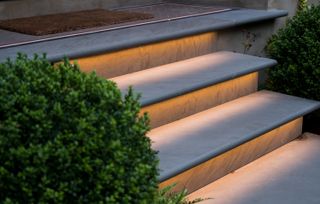
These Yorkstone sawn step treads from London Stone look particularly effective when lit at night
A well-designed set of steps can make a stunning feature when combined with garden lighting, as well as being a key safety measure.
Installing simple LED strip lighting under each overhanging tread (i.e. the flat surface that you tread on) will highlight the riser below and create a striking, striped effect.
Go for lighting with a low lumen output in a warm white shade for a soft and gentle look. It's also an effective way to highlight the shapes of each step's profile and any natural marbling.
11. Consider the step profile
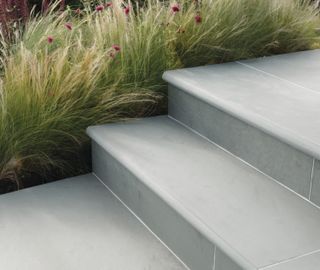
Keep it sleek and modern when it comes to choosing materials for a contemporary garden, such as this paving from Stonemarket
The front edge or profile of paved steps can make a big difference to the finished look of the feature.
Rounded or bullnose shaping works well on thicker stone or concrete products and oozes quality and a more traditional feel.
For a contemporary finish try a straight, flat profile or a chamfered design on the top or both top and bottom edges. Porcelain paving slabs tend to have a similar range of shapes but feature a downstand: essentially a right-angled overhang along the front edge of each step to create a neat, crisp, contemporary look.
12. Make steps work extra hard
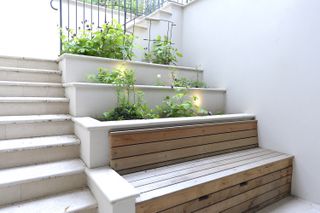
In this design by Broseley London, a neat timber slatted seat conceals plenty of handy storage
In a small garden, 'everything must work extra hard as there is often nowhere to hide,' says garden designer Kate Gould. She advises thinking about the mood that you're trying to achieve, whether it be contemporary, contemplative, or traditional.
'Perhaps you are happy with a mixture of all, but stick to the discipline of your ideas, rather than throwing all and sundry at it,' she says.
This plot demonstrates Kate's advice perfectly. It really makes the most of the steps by stretching them across the width of the space and incorporating planting, seating, and storage. The overall look feels clean, modern, and fuss-free.
To recreate the scene, opt for shade-loving plants that can cope with low-light levels – ferns, ivy, and hardy geraniums all work well. Encourage foliage to overhang each level to soften the look. In terms of how many plant varieties to choose, 'less can very much be more,' says Kate. 'Less maintenance; more impact and drama.'
13. Impress with a cantilevered design
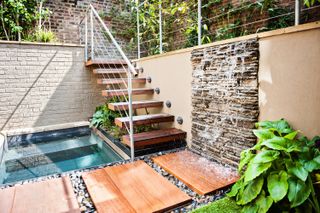
Make a set of steps the focal point of your scheme, as in this project by The Garden Builders
Definitely a job for the professionals – an outdoor cantilevered staircase makes a big style statement.
Bold and undeniably modern, it consists of a series of chunky, slab-style treads jutting out from a side wall. With barely-there railings providing support on the opposite side, the effect can be breathtaking.
Besides any lack of obvious support, the charm and impact also lie in the mix of materials used and the surfaces that surround the steps. Crisply rendered walls, panels of jagged stone, and rough brick cladding all work well with this style. Add in recessed lighting, lush planting, and perhaps a soothing water feature nearby as chic finishing touches to the scene.
14. Accentuate clean lines
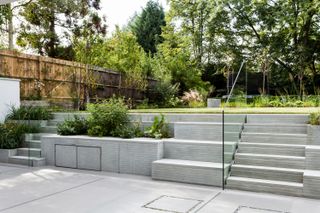
This elegant design by RDA Architects features two sets of steps, which gives the garden an easy, open feel
Low, wide steps instantly add a relaxed vibe to a garden. In fact, the lower the height of each step, the deeper the tread should be, as this will create a practical set of stairs that is super easy to use.
A riser of around 6in (150mm) between each step is comfortable for most but avoid anything less than 4in (100mm) as it could be considered a trip hazard. The sheet glass balustrades used in this modern garden are elegant and striking while the striated paving adds a touch of lightness.
15. Wow with patterned tiles
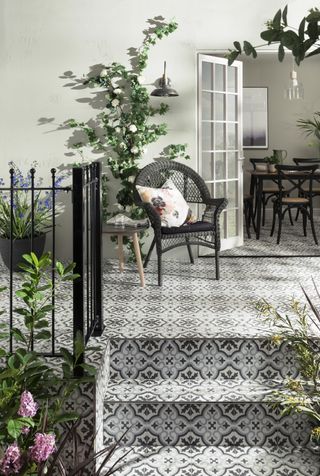
The Berkeley Essence tiles from Topps Tiles can be used inside and out
Make your garden steps part of your patio ideas by covering them all in the same flooring. Not only will it help merge the spaces and create a seamless look, but also, if you go for a bold color or pattern, it will increase the impact too.
These patterned tiles look chic teamed with simple black iron railings and handrails.
16. Opt for curvy steps
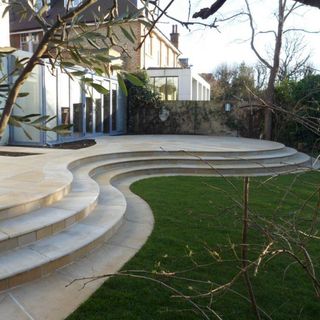
This design, by John Gale Landscapes, has several shallow but wide steps to create a soothing garden feature
There's something rather refined and elegant about curving steps. Yes, they take up more space than your average straight flight, but they instantly add interest and movement to a garden, especially when accompanied by a lush, well-kept lawn and smooth stone paving.
A rounded edge to each overhanging step – or tread – emphasizes the beautiful shape and tiered effect.
17. Lift paved steps with clipped evergreen shrubs
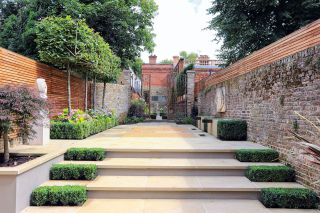
This elegant garden by Harrington Porter has box plants inset in the paved steps
Striking a balance between plants and hard landscaping can be a tricky business, but get it right and the effect is enchanting.
Shrubs, ornamental grasses, and small trees are obvious choices and look great in built-in planters or large-scale pots. But for something truly eye-catching, take a look at this project by Harrington Porter. Box plants clipped to step height add a touch of texture and elegance to this formal patio: an inspiring example of landscaping with evergreens.
18. Mix up mellow materials
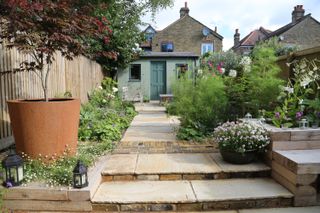
This cottage-style garden mixes different materials, including paving from London Stone, to add interest to the landscaping design
Looking for garden steps ideas with character? Try experimenting with different materials. The secret to success is to stick to finishes that have – or will weather to – a similar tone.
Sandstone flags, chunky sawn oak, and reclaimed London Stock bricks all have the same warm, golden glow and work beautifully to create a relaxed and informal feel that's perfect for cottage garden paths and steps. Be bold in scale to let the materials create impact and minimize any fussy details or unnecessary joins.
19. Create a stepped display
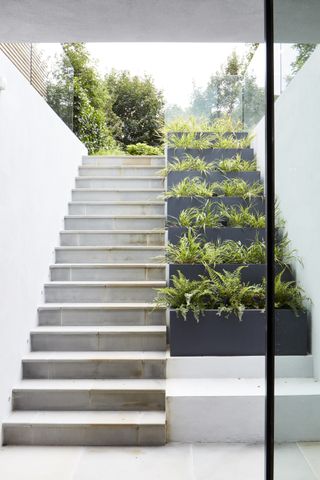
In this design by Ade Architecture, a series of contemporary planters makes for a striking addition to the modern garden steps
Besides providing access, steps make a brilliant spot for displaying container garden ideas. Depending on the size of your backyard and the area taken up by steps, the effect you can create is endless.
From a ribbon of brightly colored pots and blooms snaking up one side of the stairs to a vast potted 'flower bed' that stretches up away from your view, it is a great trick for breaking up a sea of hard landscaping.
What's more, you can move and change your display whenever you fancy. Experiment with different height plants on different levels or strike a dramatic note by repeating identical black metal planters planted with ferns, as in this design.
20. Highlight risers with pattern
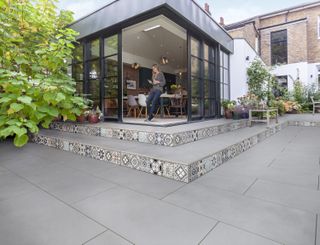
These Symphony Matte tiles from Marshalls were inspired by Victorian encaustic styles
Show off wrap-around steps or unusual interlocking designs by choosing a contrasting finish between each step. A great way to add an element of surprise, you can have fun introducing a strong, bold color or a distinctive pattern without compromising the rest of a low-maintenance paved design.
These tiles look amazing stretching along the shallow steps, flanked by the smooth, large format gray paving.
21. Soften steps with planting
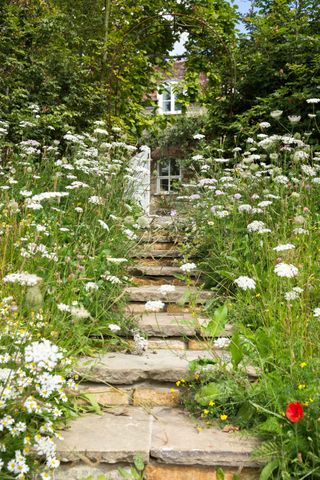
It's all about how the planting and steps work together in this cottage garden scheme by Jonathan Snow Landscape and Garden Design
No garden approach can be more romantic than threading your way through swaying meadow grasses and flowers up the garden steps. Few of us are lucky enough to have this very situation at home though, so we need to be a little creative.
Reclaimed flagstones make the perfect steps for cottage gardens. Already worn and marked by years of use, they can be set into an existing slope, supported by salvaged bricks, to create a pathway full of personality.
Cover the neighboring banks of soil with easy-to-lay matting pre-sown with native flowering meadow grasses. If you are more impatient, go for plug plants interspersed with more mature perennials right next to the steps.
22. Mix steps with water
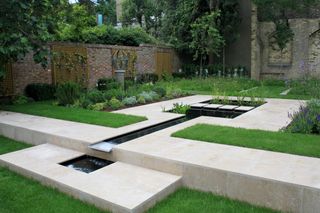
In this garden by Peter Reader Landscapes, there are only three slight changes of level but the paving together with the overflowing water is simply stunning
A change in height in a garden is a great excuse to incorporate water feature ideas.
Rills and pools spilling from one level to the next is a great way to bring movement, light, and sound to an outside space and it's hugely restful too.
Look at ways of using water creatively – it could emerge from a wall spout and travel down through rills to a lower collecting pool. Or, try a series of shallow channels that run alongside a central set of steps flowing gently over protruding water blades or down narrowing chutes.
23. Consider decorative handrails
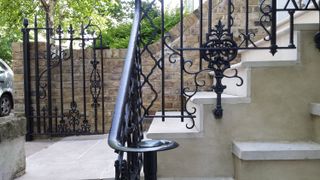
This set of steps features bespoke decorative metalwork by Orlando Richards
Safety is essential when designing steps, and if there is a drop of 24in (600mm) or more to the side you will need to install a side wall or handrail.
Yes, this will add to the overall cost but, besides ensuring everyone's well-being, it provides the chance to indulge in a gorgeous design.
Rails and panels come in a huge range of materials, each with their own distinct characteristics. Smart tensioned cables, glass panels, and laser-cut Corten steel panels all make strong statements in contemporary, urban, and coastal gardens. Curvy cast-stone balustrades, timber posts and rails, and ornate ironwork tend to suit period and rural homes.

Jill puts her love of plants and all things garden related down to the hours spent pottering around with her Nan and Grandad when she was little. Today she is lucky enough to have a garden of her own in Surrey, England, and spends much of her time writing about them too.
- Holly CrossleyActing Deputy Editor
-
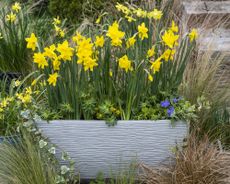 An Update on Gardeningetc
An Update on GardeningetcA word from our publisher
By Beth Murton Published
-
 Do you need to chit potatoes? Find out what the experts say
Do you need to chit potatoes? Find out what the experts sayGrow Your Own Learn how to chit potatoes before planting them in the ground and you’ll be on your way to getting an earlier and bigger harvest
By Drew Swainston Published
